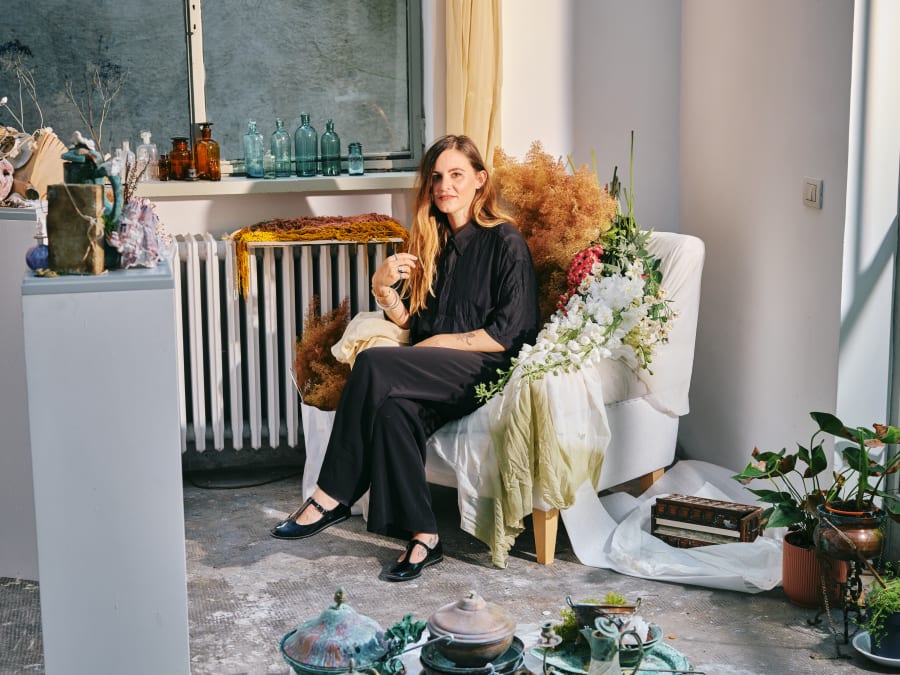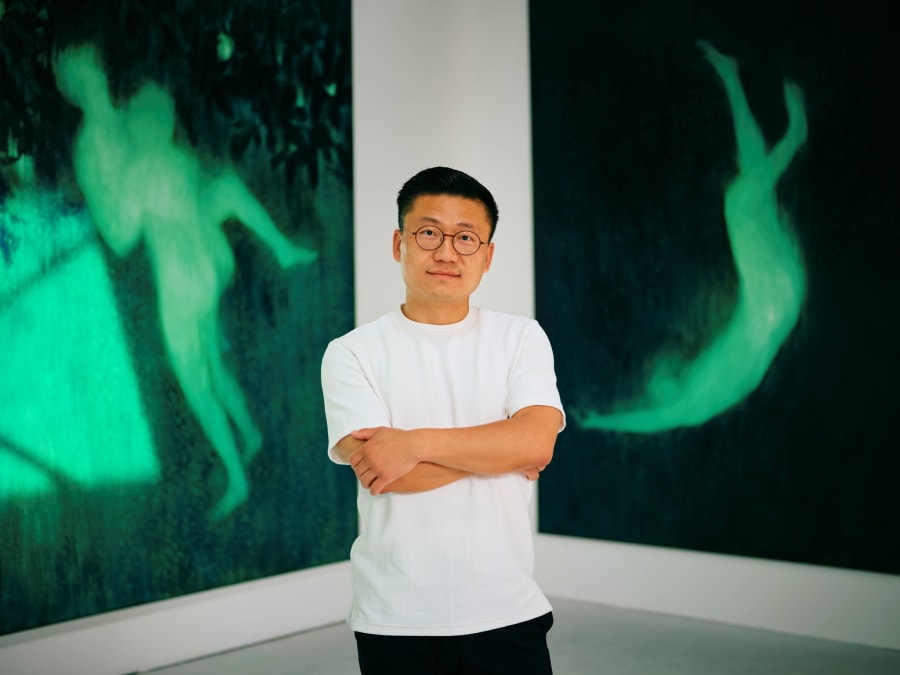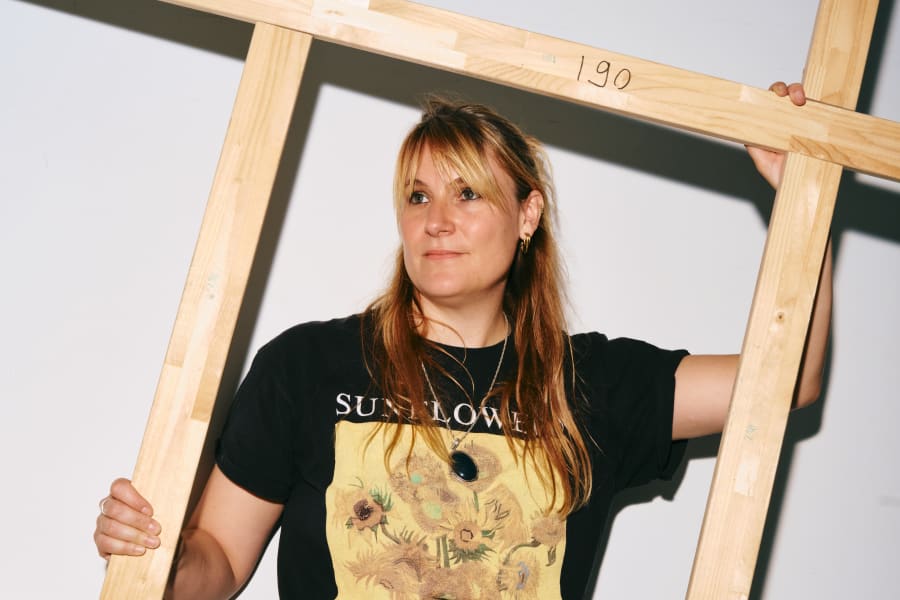In collaboration with the Centre Pompidou
With his monumental sculptures, mineral pigments, and drawings made from organic matter, Lionel Sabatté traces a line between memory and disappearance, the intimate and the universal. His work, both tactile and contemplative, speaks to the fragility of life – and the traces we leave behind. For the 2025 Prix Marcel Duchamp, the artist presents a quietly arresting installation at the Musée d’Art Moderne de Paris.
‘I was just picking up some dust from the freezer in my studio in Noisy,’ says Sabatté, casually, by way of an apology for being late. It sounds like a line from a deadpan short story. And yet, in the world of contemporary art – where urgency, ecology, and corporeality increasingly intersect – it sort of makes sense. A finalist for this year’s Prix Marcel Duchamp, Sabatté has carved out an unusual position among his generation of French artists. Rather than working with the ‘noble’ materials of traditional sculpture, he collects remnants of the living: human dust, dead skin, hair, fabric fibers, fragments of wood, and volcanic stone. Materials on the verge of vanishing.
Seated on a bench inside the Musée d’Art Moderne, where this year’s 25th edition of the prize is on view, the artist – in his late 40s – speaks in a soft, even voice about the path that brought him here. Drawing, he says, is something he has been doing since early childhood. ‘It was hard to stop. I drew everywhere – on all my books. It was like breathing.’ More than a skill, it was a reflex. ‘I knew right away it would always be part of my life.’
And yet, the path to becoming an artist was anything but direct. Raised in Toulouse, with time spent in Montauban and in Réunion, Sabatté initially imagined a career in physical education. He studied sports science in Orsay, on the outskirts of Paris. It was only at 21, after a friend took him to the art school in Nancy, that something shifted. ‘I discovered another way of thinking about the body, time, and matter,’ he recalls. He enrolled soon after at the École nationale supérieure des beaux-arts in Paris, where a deep knowledge of anatomy informed his practice in painting and sculpture.
Those years also taught him restraint. ‘Studying gave me the distance to look at what I was doing,’ he says. ‘My work as an artist is mostly about cutting back something that’s always overflowing. Without that, I’d just be a guy on the margins making things.’ After graduating in 2003, Sabatté took an independent route, distancing himself from the traditional channels. ‘My practice doesn’t really belong in the art world,’ he observes straightforwardly.
His radicalism, if we can call it that, lies in something quieter. He recalls an early encounter with the Nouveaux Réalistes at the Centre Pompidou – artists who also found value in discarded materials. But Sabatté’s approach is less urban and more organic. His signature medium is dust. This overlooked, ubiquitous residue of human life made up of hair, eyelashes, fabric fibers, and mineral traces. ‘I love dust,’ he says, ‘because it’s free, and it belongs to all of us.’ He keeps it chilled, to avoid attracting moths, shedding light as to why there is a freezer in his studio.
For the Prix Marcel Duchamp, Sabatté swept the floors of the museum itself – its corners, its forgotten spaces – gathering what remained after cleaning staff had passed through. From this, he created a new series of dust drawings: pale mosaics on white paper, forming spectral faces that seem to emerge from the walls. ‘You see the traces of everyone who’s been here,’ he says. Each fragment holds a memory – skin cells, hair – evidence of decay, but also of continuity. For Sabatté, what we discard is not waste, but a testimony.
This vision is embodied, literally, in a small sculpture placed near the entrance: a young dodo made entirely of dust. The extinct bird – ungainly, flightless, and often used as shorthand for human folly – becomes, in his hands, a vessel of quiet mourning. This one, created in the aftermath of COVID-19, is composed entirely of dust collected from the corridors of the Châtelet–Les Halles metro station, the sculpture thus containing the genetic imprint of the very species that brought it to extinction. A kind of poetic justice – part memorial, part rebirth.
In another room, a series of birds made from pozzolana – a porous volcanic stone – and lime (as used by the Romans for mortar) seem to emerge from geological time. Hybrid creatures are born of this rough material – monumental birds, seemingly hatched from the center of the earth. They could be from prehistory or from a not-so-distant future – once again it’s a question of cycles. Strange, disturbing figures – part dinosaur fossil, part elderly bird – watch over an ever-shifting landscape.
What makes Sabatté’s project for the Prix Marcel Duchamp so compelling is his sense of space – not just how to fill it, but how to invite viewers to move through it. ‘The space allowed for something to unfold,’ he says. ‘Almost like a choreography.’ This immersive, almost choreographic sensibility recalls the work of Bruce Nauman, which Sabatté first encountered at the Centre Pompidou in the late 1990s – and which left a lasting impression.
Elsewhere in the exhibition: a suspended square of fabric made from dead skin, and a large canvas created specifically for the show. ‘They’re like imagined geologies,’ he explains, ‘from which new forms of life might emerge. I imagine other planets, volcanic activity, tectonic movement. It’s as if all the other pieces could have been born from this one.’
At its core, Sabatté’s practice is not about permanence but about transformation – about what survives and what changes. His works invite us to look again at the things we tend to overlook. To see dust not as the end point, but as the beginning of something new.
This article is part of a collaboration with the Centre Pompidou for the Prix Marcel Duchamp 2025. View it here on the Centre Pompidou website.
Lionel Sabatté is represented by Ceysson & Bénétière (Paris, Luxembourg City, New York, Saint-Etienne, Tokyo).
Prix Marcel Duchamp
Musée d’Art Moderne de Paris
From September 26, 2025, to February 22, 2026
Pierre Malherbet is Editor in Chief at the Magazine, Centre Pompidou.
English translation: Art Basel.
Caption for header image: Lionel Sabatté, photographed by Guillaume Blot for Art Basel and Centre Pompidou.
Published on September 18, 2025.


